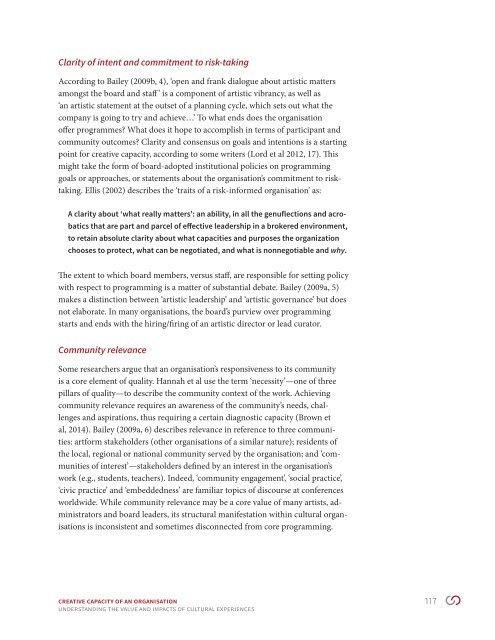aceUVi
aceUVi
aceUVi
Create successful ePaper yourself
Turn your PDF publications into a flip-book with our unique Google optimized e-Paper software.
Clarity of intent and commitment to risk-taking<br />
According to Bailey (2009b, 4), ‘open and frank dialogue about artistic matters<br />
amongst the board and staff ’ is a component of artistic vibrancy, as well as<br />
‘an artistic statement at the outset of a planning cycle, which sets out what the<br />
company is going to try and achieve…’ To what ends does the organisation<br />
offer programmes What does it hope to accomplish in terms of participant and<br />
community outcomes Clarity and consensus on goals and intentions is a starting<br />
point for creative capacity, according to some writers (Lord et al 2012, 17). This<br />
might take the form of board-adopted institutional policies on programming<br />
goals or approaches, or statements about the organisation’s commitment to risktaking.<br />
Ellis (2002) describes the ‘traits of a risk-informed organisation’ as:<br />
A clarity about ‘what really matters’: an ability, in all the genuflections and acrobatics<br />
that are part and parcel of effective leadership in a brokered environment,<br />
to retain absolute clarity about what capacities and purposes the organization<br />
chooses to protect, what can be negotiated, and what is nonnegotiable and why.<br />
The extent to which board members, versus staff, are responsible for setting policy<br />
with respect to programming is a matter of substantial debate. Bailey (2009a, 5)<br />
makes a distinction between ‘artistic leadership’ and ‘artistic governance’ but does<br />
not elaborate. In many organisations, the board’s purview over programming<br />
starts and ends with the hiring/firing of an artistic director or lead curator.<br />
Community relevance<br />
Some researchers argue that an organisation’s responsiveness to its community<br />
is a core element of quality. Hannah et al use the term ‘necessity’—one of three<br />
pillars of quality—to describe the community context of the work. Achieving<br />
community relevance requires an awareness of the community’s needs, challenges<br />
and aspirations, thus requiring a certain diagnostic capacity (Brown et<br />
al, 2014). Bailey (2009a, 6) describes relevance in reference to three communities:<br />
artform stakeholders (other organisations of a similar nature); residents of<br />
the local, regional or national community served by the organisation; and ‘communities<br />
of interest’—stakeholders defined by an interest in the organisation’s<br />
work (e.g., students, teachers). Indeed, ‘community engagement’, ‘social practice’,<br />
‘civic practice’ and ‘embeddedness’ are familiar topics of discourse at conferences<br />
worldwide. While community relevance may be a core value of many artists, administrators<br />
and board leaders, its structural manifestation within cultural organisations<br />
is inconsistent and sometimes disconnected from core programming.<br />
CREATIVE CAPACITY OF AN ORGANISATION 117<br />
UNDERSTANDING the value and impacts of cultural experiences


